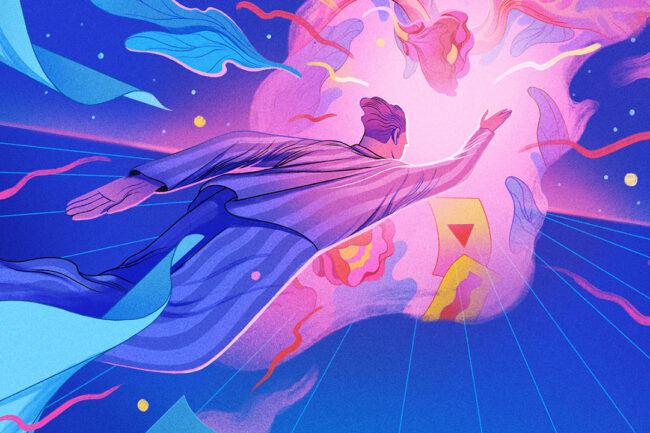 Now that we’ve explored ways of Lucid Dreaming, what can you do with it?
Now that we’ve explored ways of Lucid Dreaming, what can you do with it?
Lucid dreaming offers a fascinating realm of possibilities for exploring the depths of your subconscious mind and experiencing vivid, immersive dreamscapes. Here are some things you can do with lucid dreaming:
Control your dreams: One of the most exciting aspects of lucid dreaming is the ability to manipulate and control your dream environment. You can fly, shape-shift, teleport, or conjure up any scenario or object you can imagine.
Overcome fears and phobias: Lucid dreaming provides a safe space to confront and overcome fears and anxieties. By facing your fears in a controlled dream setting, you can desensitize yourself to them and gain confidence in real life.
Enhance creativity: Lucid dreams can be a fertile ground for creative inspiration. You can explore new ideas, solve problems, and unleash your creativity without the constraints of reality.
Practice skills and improve performance: Athletes, musicians, and performers can use lucid dreaming to rehearse and improve their skills mentally. Studies have shown that mental rehearsal in lucid dreams can lead to real-world performance improvements.
Explore inner landscapes: Lucid dreaming provides a gateway to the inner workings of your subconscious mind. You can delve into your deepest desires, fears, and memories, gaining insight into your psyche and personal growth.
Experience adventure and escapism: Lucid dreaming allows you to embark on thrilling adventures and escapades in the comfort of your own mind. You can explore fantastical realms, visit distant planets, or interact with intriguing characters.
Connect with dream characters: In lucid dreams, you can engage in conversations and interactions with dream characters, who may represent aspects of your psyche or subconscious beliefs. These interactions can provide valuable insights into your inner world.
Practice mindfulness and meditation: Lucid dreaming offers a unique opportunity to cultivate mindfulness and meditation practices within the dream state. You can explore states of heightened awareness, inner peace, and spiritual experiences.
Overall, lucid dreaming is a rich and multifaceted experience that offers endless possibilities for exploration, self-discovery, and personal growth. With practice and patience, you can unlock the full potential of your dreaming mind and harness its transformative power.

 When Mercury is retrograde in Aries, it can bring about a period of introspection, revisiting old ideas, and reevaluating communication and action. Mercury retrograde occurs when the planet appears to move backward in its orbit from our perspective on Earth. It’s often associated with communication mishaps, delays, and misunderstandings, but it can also offer opportunities for reflection and revision. Here’s what to expect during Mercury retrograde in Aries from April 1st to April 25th:
When Mercury is retrograde in Aries, it can bring about a period of introspection, revisiting old ideas, and reevaluating communication and action. Mercury retrograde occurs when the planet appears to move backward in its orbit from our perspective on Earth. It’s often associated with communication mishaps, delays, and misunderstandings, but it can also offer opportunities for reflection and revision. Here’s what to expect during Mercury retrograde in Aries from April 1st to April 25th: The Suit of Pentacles Tarot cards deal with the physical or external level of consciousness and thus mirror the outer situations of your health, finances, work, and creativity. They have to do with what we make of our outer surroundings – how we create it, shape it, transform it and grow it. On a more esoteric level, Pentacles are associated with the ego, self-esteem and self-image.
The Suit of Pentacles Tarot cards deal with the physical or external level of consciousness and thus mirror the outer situations of your health, finances, work, and creativity. They have to do with what we make of our outer surroundings – how we create it, shape it, transform it and grow it. On a more esoteric level, Pentacles are associated with the ego, self-esteem and self-image. In astrology, the second house is commonly associated with possessions, material resources, earned income, personal values, self-worth, and security. It represents how an individual relates to their material world and what they consider valuable. Here’s a breakdown of what the second house signifies:
In astrology, the second house is commonly associated with possessions, material resources, earned income, personal values, self-worth, and security. It represents how an individual relates to their material world and what they consider valuable. Here’s a breakdown of what the second house signifies: “WBTB” stands for “Wake Back to Bed,” which is a technique used to induce lucid dreaming. Lucid dreaming is the experience of being aware that you are dreaming while still in the dream state, allowing you to consciously control and manipulate the dream environment.
“WBTB” stands for “Wake Back to Bed,” which is a technique used to induce lucid dreaming. Lucid dreaming is the experience of being aware that you are dreaming while still in the dream state, allowing you to consciously control and manipulate the dream environment. Last week I talked about Body Scanning. Whenever I think about the mind and the body, I always think about the mind, body connection. Trusting your gut, your intuition. So here we are again.
Last week I talked about Body Scanning. Whenever I think about the mind and the body, I always think about the mind, body connection. Trusting your gut, your intuition. So here we are again. The Suit of Swords within the Tarot deck delves into the realm of mental consciousness, focusing on the intellect, thoughts, attitudes, and beliefs. Swords, often depicted as double-edged, symbolize the delicate equilibrium between intellect and power, showcasing how these facets can be wielded for both constructive and destructive purposes. Consequently, the Suit of Swords necessitates a harmonious integration with the spiritual (Wands) and emotional (Cups) aspects to manifest its most beneficial influence.
The Suit of Swords within the Tarot deck delves into the realm of mental consciousness, focusing on the intellect, thoughts, attitudes, and beliefs. Swords, often depicted as double-edged, symbolize the delicate equilibrium between intellect and power, showcasing how these facets can be wielded for both constructive and destructive purposes. Consequently, the Suit of Swords necessitates a harmonious integration with the spiritual (Wands) and emotional (Cups) aspects to manifest its most beneficial influence. The First House, often dubbed the House of Self, marks the beginning of the astrological journey, symbolizing the individual’s essence and initial steps into existence. At its helm lies the Ascendant, representing the zodiac sign ascending on the eastern horizon at the moment of birth. This celestial alignment parallels the rising sun, evoking notions of dawn and fresh starts, encapsulating the essence of the First House: the inception of self-awareness and personal exploration. Questions of identity, potential, and self-realization permeate this domain, prompting introspection into one’s essence and trajectory. It is here that the canvas of individuality is unfurled, each stroke contributing to the unique masterpiece we offer to the world.
The First House, often dubbed the House of Self, marks the beginning of the astrological journey, symbolizing the individual’s essence and initial steps into existence. At its helm lies the Ascendant, representing the zodiac sign ascending on the eastern horizon at the moment of birth. This celestial alignment parallels the rising sun, evoking notions of dawn and fresh starts, encapsulating the essence of the First House: the inception of self-awareness and personal exploration. Questions of identity, potential, and self-realization permeate this domain, prompting introspection into one’s essence and trajectory. It is here that the canvas of individuality is unfurled, each stroke contributing to the unique masterpiece we offer to the world. We spend most of the day in our heads, you only think about your feet when they hurt.
We spend most of the day in our heads, you only think about your feet when they hurt. A wake-initiated lucid dream (WILD) is a phenomenon in which an individual transitions directly from a waking state into a state of lucid dreaming, maintaining full consciousness throughout the process. Unlike other methods of inducing lucid dreams, such as reality checks or mnemonic induction, WILD involves consciously navigating the transition between wakefulness and dreaming.
A wake-initiated lucid dream (WILD) is a phenomenon in which an individual transitions directly from a waking state into a state of lucid dreaming, maintaining full consciousness throughout the process. Unlike other methods of inducing lucid dreams, such as reality checks or mnemonic induction, WILD involves consciously navigating the transition between wakefulness and dreaming.